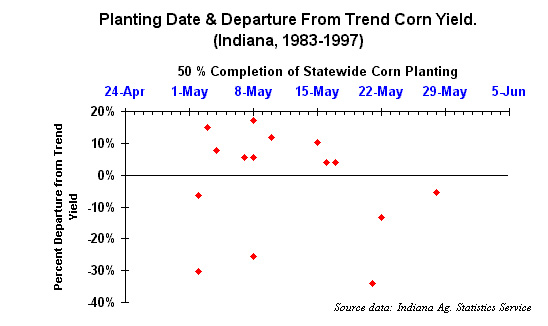
Figure 1.
The April 27 issue of the Indiana Weekly Weather & Crops Report (Vol. 48, No. 4) told us that the state's corn planting progress as of April 26 was only 3 % complete, compared to 26 % last year and 11 % average completion during the past five years. Fear-mongers among us have already begun to wail about the effects of a late start to planting on the crop's yield potential. This fear, coupled with the uncertain and unpredictable effects of El Niño this coming summer, encourages some to write off the 1998 corn crop altogether.
How important a predictor of statewide corn yield is planting date? Interestingly enough, the planting date effect on yield is somewhat paradoxical.
It is true that for any given field, delayed planting beyond early May will likely result in lower corn yields due to a number of factors: shorter growing season, insect & disease pressure, moisture stress during pollination, etc. However, if one reviews the data for average statewide planting dates and corn yield for the past fifteen years, there is NOT a strong relationship between the date by which half of the state's corn is planted and the statewide average corn grain yield (Fig. 1). In fact, only about 3 % of the variability in statewide corn grain yield during the past fifteen years is related to planting date.

Figure 1.
So what's the deal? Why do agronomists preach about the importance of timely planting and yet the statewide statistical data do not appear to substantiate this importance? Let me try to explain.
Simply put, planting date is not a single predictor of absolute yield in a given field for a given year. In other words, although we know that early-planted corn will usually yield more than later-planted corn, the exact yield level is dependent on a host of other yield-influencing factors. Therefore, it is possible for early-planted corn in one year to yield more than, less than or equal to later-planted corn in another year depending on the exact mix of yield-influencing factors for each year.
For example, the crop years 1996 and 1997 represent the latest and earliest planting dates in the past fifteen years. The dates by which half of the state's corn crop was planted in 1996 and 1997 was May 28 and May 2, respectively. Yet, the average statewide corn yields were identical at 123 bushels per acre each year (Indiana Ag. Statistical Service).
Bottom Line: Don't carried away about the influence of planting date on total corn production. While important, planting date is only one of many yield-influencing factors for corn.